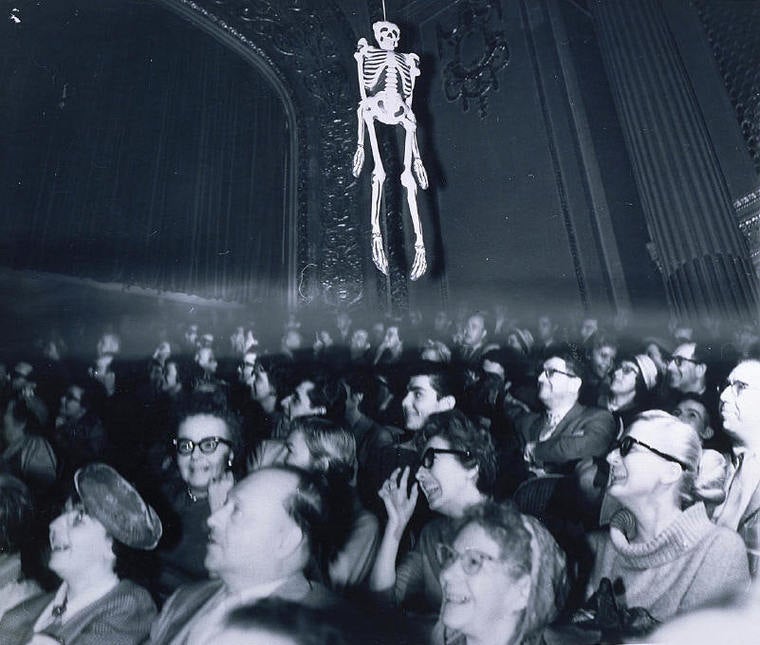Harry Price (1881-1948) was unquestionably the premiere paranormal investigator of early-mid 20th century England. This excellent website devoted to his career and legacy should be required reading for anyone interested in the ghost racket.
This 2015 ITV telemovie is very loosely based on Neil Spring’s HP-inspired novel, The Ghost Hunters (2013). In effect, being filtered through two different fictional media, the detail of the movie’s plot admits only a little historical accuracy; but of course, as a work of fiction it makes no claim of documentary realism and can only be fairly judged on its own merits.
The story opens with HP (Rafe Spall) conducting a dramatic seance at a home in London during, or very shortly after, the First World War. As it then transpires, Price has gimmicked the sitting for maximum spooky effect. Clearly, he is riding high as a ghost racketeer – until, shockingly, a disturbed young soldier who has bought into Price’s line of afterlife patter commits suicide right in front of him.
(Cut to the opening titles, a nice montage of the tools of the ghost-hunter’s trade – ’20s-vintage cameras, phonographs, metronomes and other such apparatus.)
Several years later, a sadder and wiser Harry Price has changed tack and is making his living as an investigator of seemingly paranormal phenomena, with the cloud of his former charlatanry hanging heavily about him. He is hired to investigate the strange case of Grace Goodwin (Zoe Boyle), the young wife of fast-rising Liberal MP Edward Goodwin (Tom Ward); Grace has recently been discovered wandering the streets of London, naked and disoriented, and seems to be suffering from a case of ghostly possession.
Price visits the couple’s home and quickly learns that it is a former workhouse. Sarah Goodwin’s strange visions seem to revolve around the ghost of a young boy who died there many years before.
HP is assigned the couple’s maid, Sarah Grey (Cara Theobold) as an assistant and discovers her to be a natural skeptic and a shrewd detective in her own right. Sarah has her own reason to distrust psychic mediums; her mother is a seance groupie, spending money they can’t afford in a series of attempts to contact her late husband. The point is effectively made that mediums, for all their frequent chicanery, were often the closest thing to therapists available to ordinary people during the early 20th century.
In an interlude from the main action, Price disrupts and debunks one of these public seances, for all the good it does; the true believers in the audience boo him off the stage and then the angry psychic strikes a nerve in aggressively cold reading Harry backstage, provoking Harry to knock him down. Eventually, we gather that Harry’s wife was sadly lost to insanity and that Harry seems to blame himself for not being able to help her.
Harry and Sarah proceed to puzzle out clues and mysteries towards discovering the real source of Mrs. Goodwin’s bizarre behaviour, calling upon the additional help of two of HP’s associates as the case becomes ever more convoluted.
Albert Ogoro (Richie Campbell) is a chemist by day and faux-voodoo witch-doctor by night. His main function in the story, other than to provide chemical analysis, is to illustrate another perspective on the ethics of the ghost racket. From Albert’s point of view, his clients are in such desperate straits that, if his sham-shamanism offers them some comfort, what’s the harm? He applies that logic in “assisting” Harry during a late-night vigil at the Goodwin home, but in this case his trickery (in the form of a rather implausible mechanical spider device secreted inside a grand piano) does no particular good.
Vernon Wall (Lewis Reeves), a hard-nosed young reporter who clearly has some unresolved “history” with Harry, nevertheless also agrees to help and tracks down a former secret lover of Mrs. Goodwin’s, whose presence in the Goodwins’ lives seems to have sparked the current dire situation. As it transpires, the politician is insanely possessive of his wife and, upon discovering her infidelity (and that she was pregnant with another man’s baby), he began secretly dosing her with home-brewed barbiturates, causing her to miscarry and then suffer terrifying hallucinations as she withdrew from the drug.
Goodwin reacts violently when Sarah confronts him with the truth and knocks her unconscious. Very curiously, as she comes to, she seems to see the same ghostly young boy who has been haunting Grace Goodwin. Charitably, it might be assumed that Sarah is now so deeply involved with the case that her imagination conjured a spectral child; less charitably, this vision reads as an incongruous “maybe it’s all true after all” cop-out on behalf of the writer. There’s no time to worry about that, though, as Mr. Goodwin has gone berserk and is attempting to drown his wife in the bath tub – but Harry Price arrives in the nick of time and saves the day.
The story ends with Harry inviting Sarah, who is now out of a job, to become his full-time assistant. She says she’ll think about it – leaving the way open for their adventures to be continued in some form, perhaps as a regular series …
RATING:
‽ ‽ ‽ ‽ ‽ ‽ ‽_ _ _
Seven ibangs out of ten for this effective, atmospheric and well-acted ghost-hunter procedural.

